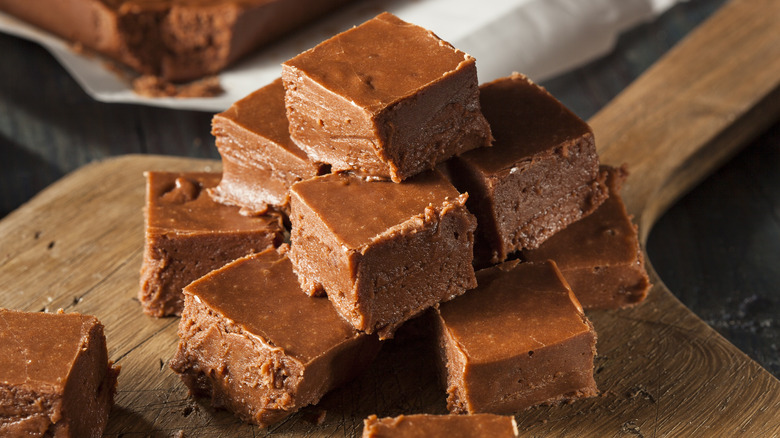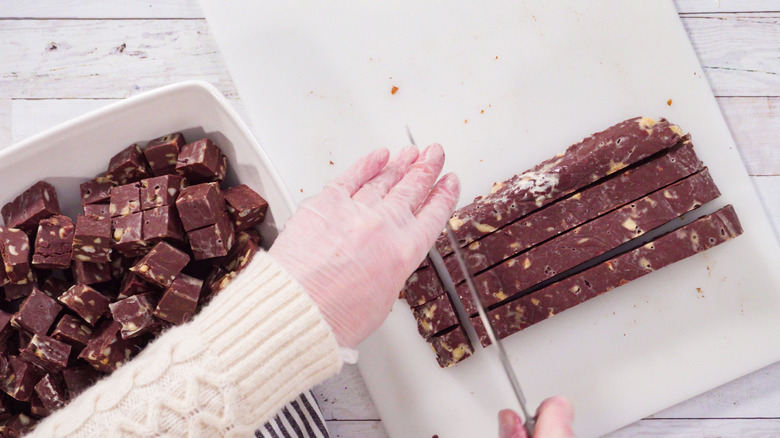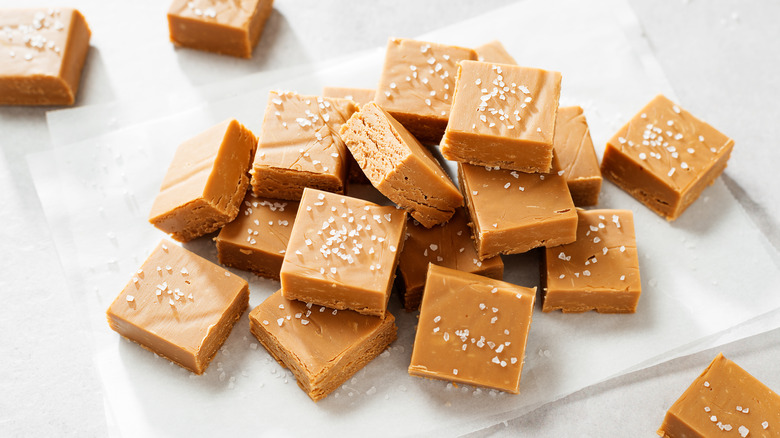The Exact Difference Between Chocolate And Fudge
The terms "chocolate" and "fudge" never seem to be too far away from each other. There are your standard bars of chocolate, but also chocolate fudge brownies, hot chocolate fudge perfect for drizzling over ice cream, and just plain old fudge bars, which could be flavored with peanut butter, salted caramel, vanilla, or, you guessed it, chocolate. Both chocolate and fudge are tasty sweet treats, but, for the most part, the similarities end there. When it comes to taste, texture, and the candy-making process, there are quite a few differences between these confectionery classics.
At the most basic level, chocolate is hard, dense, and brittle when at room temperature, whereas fudge has a soft and chewy texture. The texture of fudge is so distinct and familiar to baking communities that it's oftentimes used to describe other desserts, as with the phrase, "a dense, fudgy cookie." As for flavors, the unmistakable taste of chocolate is inherent to the cacao beans used to make it, while the taste of fudge can be easily changed according to the candymaker's whims. Absent any additional flavorings, fudge has a sweet, buttery taste, and chocolate has a slightly bitter, roasted one.
Chocolate and fudge have very different recipes
The differences between chocolate and fudge are due to the two sweets' unique recipes. Chocolate is made by harvesting, fermenting, roasting, and deshelling raw cacao beans. The resulting cocoa solids and cocoa butter are then ground and mixed with sugar and other ingredients before being tempered, shaped, and packaged. A chocolate bar's cocoa percentage, which you can often see printed on the label, depends on how much cocoa product ends up in the final recipe. For example, chocolate with a cocoa percentage of 75% is made of three parts cocoa product to one part other ingredients.
While chocolate requires tropically-derived cacao beans, fudge is made almost entirely with the kitchen staples, sugar, butter, and milk. These ingredients, along with a bit of salt, are boiled and stirred until the mixture's temperature reaches around 235 degrees Fahrenheit. This is known as the soft-ball candy stage and is pivotal when making fudge and similar treats like fondant and pralines. It's at this point that the heat can be shut off and flavorings and mix-ins can be added to the fudge. Chopped nuts, marshmallows, and of course, chocolate are all popular fudge inclusions. The fudge cooling process is just as crucial as the heating stage, and how it forms that dense, almost-crystalline structure before it's sliced up and served.
Chocolate is much older than fudge
There will be specific variations in nutrition depending on what kind of fudge or chocolate you buy or make, but there are some general health differences between the two sweets. Compared to a piece of dark chocolate, fudge has more sugars but less saturated fats. Chocolate actually has some health benefits; according to Healthline, it is a good source of fiber and contains a lot of important minerals like iron and manganese. All types of chocolate may contain these nutrients, but since dark chocolate typically has less sugar, that's usually what people opt for when they're after chocolate's healthier elements.
Chocolate is also used more as an ingredient than fudge is, making chocolate much more versatile. Just as chocolate can be used to flavor fudge, it can flavor countless other sweets like ice cream, hot chocolate, brownies, and more. Fudge can be broken apart and incorporated into sweets like cake or cookies, but chocolate can be used to make anything from chocolate-covered strawberries to savory mole sauce. Of course, one of the most important similarities between fudge and chocolate is that they are both delicious in their final form, and can enhance any dish they are added to.


